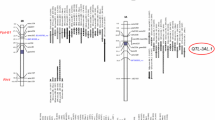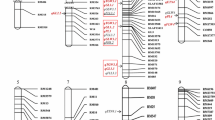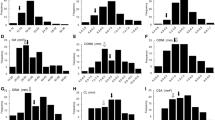Abstract
To detect QTLs controlling traits of agronomic importance in rice, two elite homozygous lines 9024 and LH422, which represent the indica and japonica subspecies of rice (Oryza sativa), were crossed. Subsequently a modified single-seed-descent procedure was employed to produce 194 recombinant inbred lines (F8). The 194 lines were genotyped at 141 RFLP marker loci and evaluated in a field trial for 13 quantitative traits including grain yield. Transgressive segregants were observed for all traits examined. The number of significant QTLs (LOD ⩾ 2.0) detected affecting each trait ranged from one to six. The percentage of phenotypic variance explained by each QTL ranged from 5.1% to 73.7%. For those traits for which two or more QTLs were detected, increases in the traits were conditioned by indica alleles at some QTLs Japonica alleles at others. No significant evidence was found for epistasis between markers associated with QTLs and all the other markers. Pleitropic effects of single QTLs on different traits are suggested by the observation of clustering of QTLs. No QTL for traits was found to map to the vicinity of major gene loci governing the same traits qualitatively. Evidence for putative orthologous QTLs across rice, maize, oat, and barley is discussed.
Similar content being viewed by others
References
Abler BSB, Edwards MD, Stuber CW (1991) Isoenzymatic identification of quantitative trait loci in crosses of elite maize inbreds. Crop Sci 31:267–274
Ahn SN, Tanksley SD (1993) Comparative linkage maps of the rice and maize genomes. Proc Natl Acad Sci USA 90:7980–7984
Ahn SN, Anderson JA, Sorrells ME, Tanksley SD (1993a) Homoeologous relationships of rice, wheat and maize chromosomes. Mol Gen Genet 241:483–490
Ahn SN, Bollich CN, AM McClung, Tanksley SD (1993b) RFLP analysis of genomic regions associated with cooked-kernel elongation in rice. Theor Appl Genet 87:27–32
Beavis WD, Grant D, Albertsen M, Fincher R (1991) Quantitative trait loci for plant height in four maize populations and their associations with qualitative genetic loci. Theor Appl Genet 83:141–145
Beavis WD, Smith OS, Grant D, Fincher R (1991) Identification of quantitative trait loci using a small sample of topcrossed and F4 progeny from maize. Crop Sci 34:882–896
Causse MA, Fulton TM, Cho YG, Ahn SN, Chunwongse J, Wu K, Xiao J, Yu Z, PC Ronald, Harrington SE, Second G, McCouch SR, Tanksley SD (1994) Saturated molecular map of the rice genome based on an interspecific backcross population. Genetics 138:1251–1274
Champoux MC, Wang G, Sarkarung S, qMackill DJ, O'Toole JC, Huang N, McCouch SR (1995) Locating genes associated with root morphology and drought avoidance in rice via linkage to molecular markers. Theor Appl Genet 90:968–981
Cho YG, Eun MY, McCouch SR, Chae YA (1994) The semidwarf gene, sd-1, of rice (Oryza saliva L.). II. Molecular mapping and marker-assisted selection. Theor Appl Genet 89:54–59
Data Description, Inc. (1992) Data Desk: Statistics Guide. Data Description, Inc., Ithaca, N.Y.
Doebley J, Bacigalupo A, Stec A (1994) Inheritance of kernel weight in two maize-teosinte hybrid populations: implications for crop evolution. J Hered 85:191–195
Edwards MD, Helentjaris T, Wright S, Stuber CW (1992) Molecular-marker-facilitated investigations of quantitative trait loci in maize.4. Analysis based on genome saturation with isozyme and restriction fragment length polymorphism markers. Theor Appl Genet 83:765–774
Everson EH, Schaller CW (1955) The genetics of yield differences associated with awn barbing in the barley hybrid (Lion x Atlas10) x Atlas. Agron J 47:276–280
Hayes PM, Liu BH, Knapp SJ, Chen F, Jones B, Blake T, Franckowiak J, Rasmusson D, Sorrells M, Ullrich SE, Wesenberg D, Kleinhofs A (1993) Quantitative trait locus effects and environmental interaction in a sample of North American barley germplasm. Theor Appl Genet 87:392–401
Koester RP, Sisco PH, Stuber CW (1993) Identification of quantitative trait loci controlling days to flowering and plant height in two near-isogenic lines of maize. Crop Sci 33:1209–1216
Kosambi DD (1994) The estimation of map distances from recombination values. Ann Eugen 12:172–175
Lander ES, Green P, Abrahamson J, Barlow A, Daly MJ, Lincoln SE, Newburg L (1987) Mapmaker: an interactive computer package for constructing primary genetic linkage maps of experimental and natural populations. Genomics 1:174–181
Li Z, Pinson SRM, Stansel JW, Park WD (1995) Identification of quantitative trait loci (QTLs) for heading date and plant height in cultivated rice (Oryza sativa L). Theor Appl Genet 91:374–381
Lincoln S, Daly M, Lander E (1992a) Constructing genetics maps with MAPMAKER/EXP 3.0. Whitehead Institute Technical Report, 3rd edn.
Lincoln S, Daly M, Lander E (1992b) Mapping genes controlling quantitative traits with MAPMAKER/QTL 1.1. Whitehead Institute Technical Report, 2nd edn.
Manly KF (1993) A Macintosh program for storage and analysis of experimental genetic mapping data. Mamm Genome 4:303–313
McCouch SR, Kochert G, Yu ZH, Wang ZY, Khush GS, Coffman RW, Tanksley SD (1988) Molecular mapping of rice chromosomes. Theor Appl Genet 76:815–829
Olufowote JO (1994) Analysis of chromosomal regions associated with some quantitative traits in barley using restriction fragment length polymorphism (RFLP) markers. PhD dissertation, Cornell University, Ithaca, New York, pp 45–46
Paterson AH, Lander ES, Hewitt JD, Peterson S, Lincoln SE, Tanksley SD (1988) Resolution of quantitative traits into Mendelian factors by using a complete RFLP linkage map. Nature 335:721–726
Paterson AH, Damon S, Hewitt JD, Zamir D, Rabinowitch HD, Lincoln SE, Lander ES, Tanksley SD (1991) Mendelian factors underlying quantitative traits in tomato: comparison across species, generations, and environments. Genetics 127:181–197
Rasmussen JM (1935) Studies on the inheritance of quantitative characters in Pisun: I.Preliminary note on the genetics of flowering. Hereditas 20:161–180
Robertson DS (1985) A possible technique for isolating genic DNA for quantitative traits in plants. J Theor Biol 117:1–10
Saito A, Yano M, Kishimoto N, Nakagahra M, Yoshimura A, Satito K, Kuhara S, Ukai Y, Kawase M, Nagamine T, Yoshimura S, Ideta O, Ohsawa R, Hayano Y, Iwata N, Sugiura M (1991) Linkage map of restriction fragment length polymorphism loci in rice. Japan J Breed 41:665–670
Sax K (1923) The association of size differences with seed coat pattern and pigmentation in Phaseolus vulgaris. Genetics 8:552–560
SAS Institute, Inc (1988) SAS Users Guide: Statistic. SAS Institute, Cary, N.C.
Schön CC, Lee M, Melchinger AE, Guthrie WD, Woodman WL (1993) Mapping and characterization of quantitative trait loci affecting resistance against second-generation European corn borer in maize with the aid of RFLPs. Heredity 70: 648–659
Schön CC, Melchinger AE, Boppenmaier J, Brunklaus-Jung E, Herrmann RG, Seitzer JF (1994) RFLP mapping in maize: quantitative trait loci affecting testcross performance of elite European flint lines. Crop Sci 34:378–389
Siripoonwiwat W (1995) Application of restriction fragment length polymorphism (RFLP) markers in the analysis of chromosomal regions associated with some quantitative traits for hexaploid oat improvement. Msc thesis, Cornell University, Ithaca, New York
Stuber CW, Lincoln SE, Wolff DW, Helentjaris T, Lander ES (1992) Identification of genetic factors contributing to heterosis in a hybrid from two elite maize inbred lines using molecular markers. Genetics 132:823–839
Tanksley SD (1993) Mapping polygenes. Annu Rev Genet 27:205–233
Tanksley SD, Young ND, Paterson AH, Bonierbale MW (1989) RFLP mapping in plant breeding: new tools for an old science. Biotechnology 7:247–264
Thoday JM (1961) Location of polygenes. Nature 191: 368–370
Van Deynze AE, Nelson JC, O'Donoughue LS, Ahn SN, Siripoonwiwat W, Harrington SE, Yglesias ES, Braga DP, McCouch SR, Sorrells ME (1995 a) Comparative mapping in grasses. Oat relationships. Mol Gen Genet (in press)
Van Deynze AE, Nelson JC, Yglesias ES, Harrington SE, Braga DP, McCouch SR, Sorrells ME (1995 b) Comparative mapping in grasses. Wheat relationships. Mol Gen Genet (in press)
Veldboom LR, Lee M (1994) Molecular-marker-facilitated studies of morphological traits in maize. II. Determination of QTLs for grain yield and yield components. Theor Appl Genet 89: 451–458
Veldboom LR, Lee M, Woodman WL (1994) Molecular-marker-facilitated studies in an elite maize population. I. Linkage analysis and determination of QTL for morphological traits. Theor Appl Genet 88:7–16
Wang G, Mackill DJ, Bonman JM, McCouch SR, Champoux MC, Nelson RJ (1994) RFLP mapping of genes conferring complete and partial resistance to blast in a durably resistant rice cultivar. Genetics 136:1421–1434
Xiao J, Yuan L (1988) The heterosis of F1 hybrids between indica and japonica and their relationship with their parents. Hybrid Rice 9:5–9
Xiao J, Li J, Yuan L, Tanksley SD (1995) Dominance is the major genetic basis of heterosis in rice as revealed by QTL analysis using molecular markers. Genetics 140:745–754
Xu YB, Shen ZT, Xu JC, Chen Y, Zhu LH (1993) Mapping quantitative trait loci via restriction fragment length polymorphism markers in rice. Rice Genet Newslett 10:135–138
Xu YB, Shen ZT, Chen Y, Zhu LH (1995) Molecular mapping for quantitative trait loci controlling yield component characters using a maximum likelihood method in rice (Oryza saliva L.). Acta Genet Sini 22:46–52
Young ND, Tanksley SD (1989) Restriction fragment length polymorphism maps and the concept of graphical genotypes. Theor Appl Genet 77:95–101
Author information
Authors and Affiliations
Additional information
Communicated by F. Salamini
Rights and permissions
About this article
Cite this article
Xiao, J., Li, J., Yuan, L. et al. Identification of QTLs affecting traits of agronomic importance in a recombinant inbred population derived from a subspecific rice cross. Theoret. Appl. Genetics 92, 230–244 (1996). https://doi.org/10.1007/BF00223380
Received:
Accepted:
Issue Date:
DOI: https://doi.org/10.1007/BF00223380




